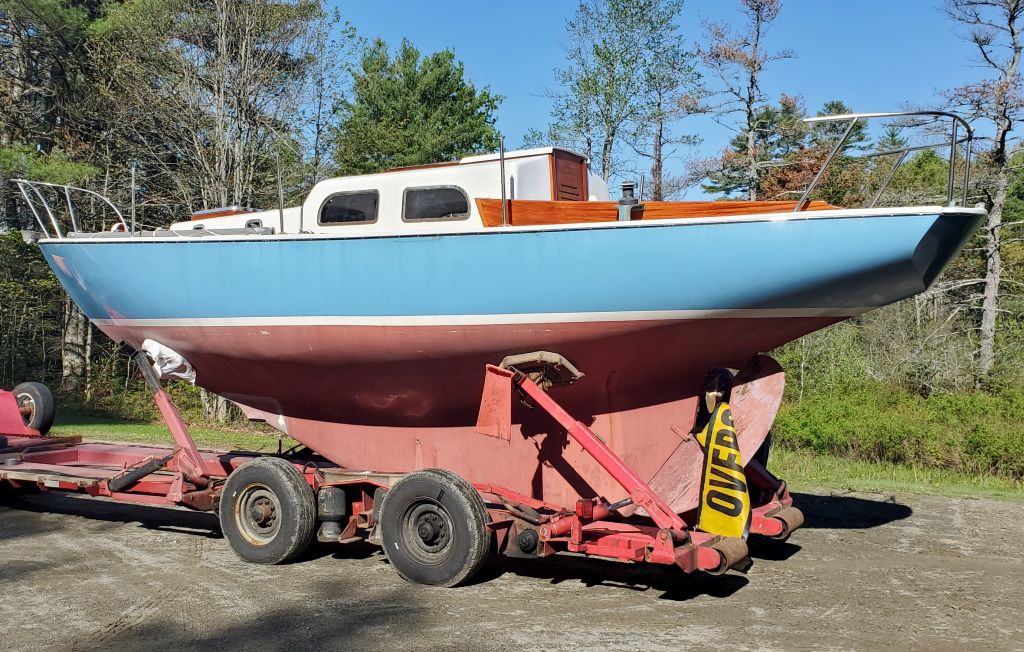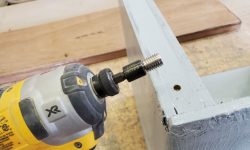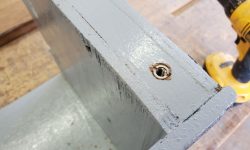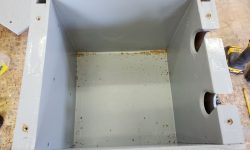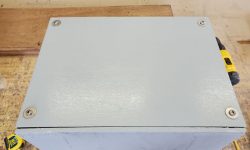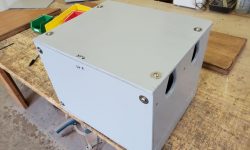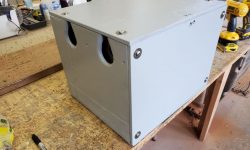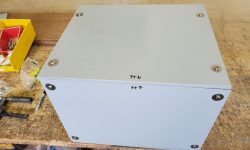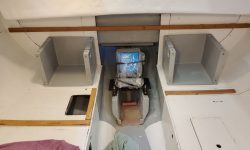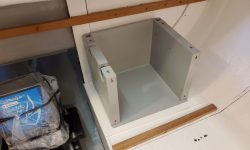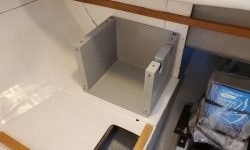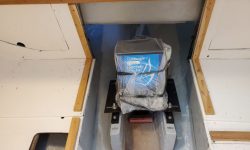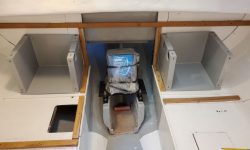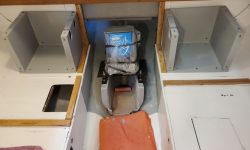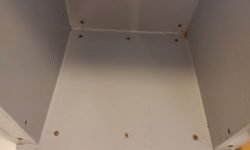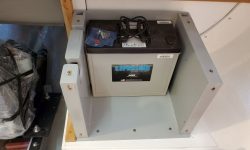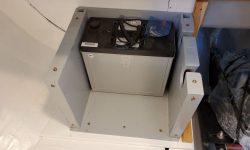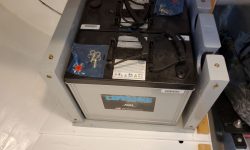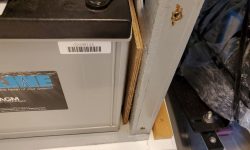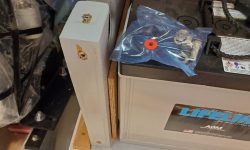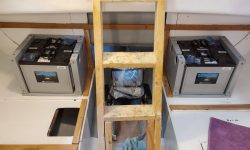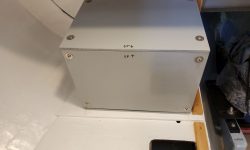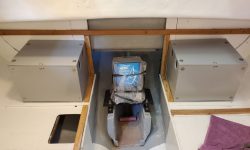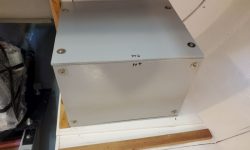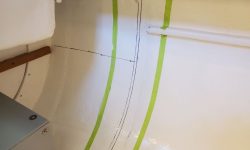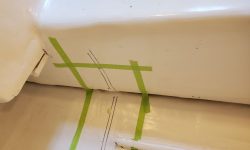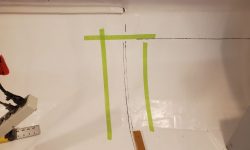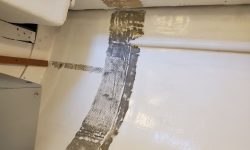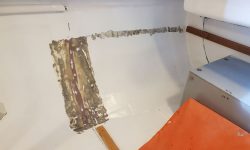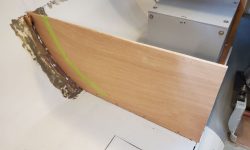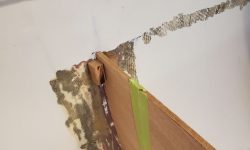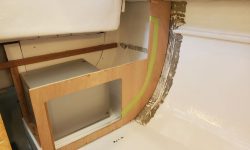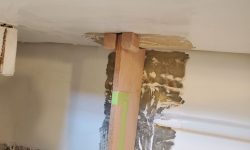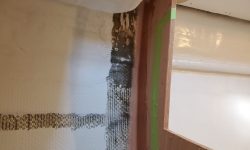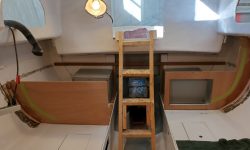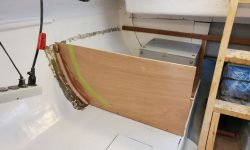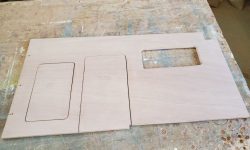March 11, 2021
Lyra 36
Thursday
Now that the painting was complete, to finish up the battery boxes I installed a series of stainless steel threaded inserts to accept fasteners from the removable front and top panels. These inserts, with sharp, aggressive outer threads, got installed in a predrilled hole in the wood with a special installation bit, and provided 1/4-20 machine screw threads on the inside. I installed eight on each box: four each for the top and front panels.
Test-fitting the boxes in the boat, I found immediately that my thought of using the boxes to support the longitudinal engine room panels was not going to work, as the various undulations of the original boat structure meant that the boxes did not line up perfectly with the plane of the panels. So I installed more hardwood cleats to line the engine space, which would ultimately support the panels.
I permanently installed the battery boxes with eight screws per side: Six through the box bottoms into the reinforced berths beneath; and two longer ones in the backs and into the fiberglassed portion of the aft bulkhead.
Now, working carefully to avoid excess strain on the capable, yet aging, machinery, I carried the four main batteries up and into the boat and installed them in the boxes. If I were into video, this would be one of those stop-action montages showing the boxes filling themselves one battery at a time. Astute viewers might notice that I actually reversed the direction of the first battery after I took the photo (as in the third photo), as upon reflection and consideration of the wiring it seemed that having the terminals for each battery end up at the fore and aft edges of the box would work out better.
I was pleased with the expansiveness of the opening in the port bulkhead, which clearly would give adequate room to move the batteries as well as good access to the remainder of the locker.
Because the inside dimensions of the boxes were slightly larger than the batteries, there was a bit of room within, and to help hold the batteries securely I cut and installed some plywood spacers to fill the gaps. Afterwards, I installed the fronts more or less permanently, and, for protection, installed the tops as well, though wiring was still to come. To that end, I made some rough measurements so I could order the necessary cable and have it on hand for the coming week.
Now that the batteries were in place, I could move ahead with the final installation of the galley parts, at least what was prepared so far. At each bulkhead location, I marked and ground away the paint and other coatings from the hull (and deck, to port) to provide bare laminate for bonding purposes. I also removed the paint from narrow strips aft of each bulkhead in way of the future countertop location, to allow for some cleats to support the countertops along the hull. This all made far more of a mess than I would have thought (and did think) possible, but I took the opportunity to do a good cleanup, and also aired out the shop since it was an incredibly nice day near 60°, a real pleasure (if taunting) for March.
With the surfaces thusly prepared, I completed the first installation step for the two main galley bulkheads, after masking off the bulkheads in preparation for tabbing. To hold the bulkheads securely in place while being installed, I used small glue blocks as needed to hold each bulkhead plumb and in the right position, and after these preparations epoxy-coated the plywood edge and installed the bulkheads with screws along the settee cleats, and epoxy fillets where they met the hull and deck, leaving this to cure overnight.
Earlier, while installing the battery boxes, I’d marked the engine room bulkheads in way of the battery box wiring holes, and now down on the bench I cut out oversized sections to provide clear passage for the wiring through the narrow space between the bulkheads and batteries. Meanwhile, I finalized the cutouts on the starboard side, including the battery access panel and, just forward, an opening for access to a storage locker beneath the sink. These bulkheads awaited final installation next time.
Total time billed on this job today: 6.25 hours
0600 Weather Observation: 35°, cloudy. Forecast for the day: Partly sunny, 53°


